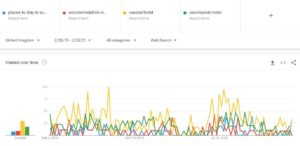These insights, paired with your web marketing analytics, can help you more effectively adjust your marketing strategy and ensure you’re delivering on travellers’ needs.
We will be covering:
Make Use of Google Trends
Prospective travellers proactively look on search engines before they book a holiday to get ideas and inspiration for their next destination. But to be visible to potential customers, your website should pick be optimised for relevant search queries. To help you determine what travellers are searching for – and what they are not – compared to other queries or topics, Google Trends is a fantastic resource and great starting place to help you optimise your digital performance.
Questions you should be asking:
- Do I rank on page one for ‘insert search term’?
- Do I have content relevant to these keywords on my website?
- Who is ranking highly and why?
- Where are my direct competitors ranking?
- Do I have a paid digital strategy in place to ensure I am visible for these queries?
Use Google Trends to really dig deep into what people may be searching for when trying to book a break with you and what terms are more popular than others – are they searching ‘places to stay in Suffolk’ or ‘accommodation in Suffolk, ‘coastal hotels’ or ‘countryside hotels’ etc.

Along with search terms, Google Trends can help you identify trends, monitor rising topics in the travel sector and provide you with keywords to add to your tracking tools and help position you in front of travellers.
Do your research
So, you’ve figured out some of the trends and keywords in your industry or sector, now it’s time to conduct some research. Take some time to look into your competitors. This is not just the brands that you think are competitors, but also those that are in your space and ranking higher than you on search engines.
Ask yourself:
- What are they are doing that you could be doing as well (but better!)?
- What search terms are they ranking for and why?
- Are they covering various topics?
- Is there a variety of different content? E.g., video, imagery, FAQs
What landing pages are appearing? For example, ‘Suffolk things to do’. Does this hint at what the search intent might be for this query? From here, you should have a good idea on some of the keywords you want to be ranking for, as well as understanding those you already rank well for. Next step in your research should be carrying out search query analysis and utilising tools such as Google Keyword Planner and Moz to help form the basis of a content strategy.
Finally, make sure to review your website content for any quick wins, such as incorporating newly discovered keywords into your copy and meta titles/descriptions.
Gap and Opportunity Analysis
Once you have done your research and have identified your keywords, it’s time to perform a Gap analysis – simply finding the ‘gaps’ in your organic visibility (where you rank poorly) and identifying how you can plug those ‘gaps’ with paid search. This allows you to get in front of your customers in key booking periods whilst you look to improve your overall organic positioning. Over time, you can also use this paid data to understand how this may perform for you in organic search and whether it’s actually worth the time and content.
Utilising data from your research including how competitors are optimising their content to match relevant search intent allows you to identify short-term ranking opportunities. For example, search term queries that rank on page two – often referred to as low-hanging fruit – usually provide a greater chance of short-term gains.
Utilise your data
Travel isn’t an impulse buy. The process of booking from initial interest, research, and price comparison to booking is a long and thorough process. Understanding the customer journey is incredibly important when it comes to digital marketing. Google breaks down the micro-moments that inform the travel decision making process:
- Dreaming – The ‘I want to get away’ moment – it’s here where prospective travellers are open to ideas. They haven’t made a decision about where to go or what to do, but they know they want a holiday or break.
- Planning – The ‘time to make a plan’ moment – the traveller, at this stage, has chosen a destination and is now looking at dates, places to stay and planning the activities they would like to do.
- Booking – The ‘let’s book it’ moment – with all the above research done, the traveller is now looking to book and make reservations.
- Experiencing – The ‘I can’t wait to explore’ moment – the journey doesn’t end at the booking confirmation. At this stage, the traveller is enjoying their trip and sharing it with others on social platforms. They may also still be looking at other activities and experiences whilst staying.
Using the above process, act as if you are a customer, and are considering booking a holiday. Now think:
- Does your website inspire you to visit the destination?
- Have you included content on local attractions, things to do etc.?
- Is the booking engine easy to use when finding dates and filtering room information?
- Do you have a brand ‘hashtag’ to create user generated content on social media?
- Do you encourage people to leave reviews on TripAdvisor, Trustpilot, and Google?
When it comes to data it is also worth looking a little deeper to find out where your customers are coming from and again, using the Gap analysis, work out what opportunities there are for you to reach wider audiences. Now is the time to look through your Google Analytics account and work out:
- Where are your customers coming from? Organic, direct or paid search?
- Which pages perform best on your website?
- Which pages do not perform well?
- Looking into the booking journey, are there any common dropout points?
- What are people doing on your website?
- Are there any pages you could improve quickly?
Using all the above information should allow you to now focus on your content strategy and put your learnings into practise.
Prepare digital advertising
When it comes to digital advertising, preparation is key.
Now the government has outlined key dates for re-opening the industry, it’s time to get a start on writing up your ad copy for all your digital advertising – think Google Ads, Microsoft (Bing) Advertising and social media advertising. From the initial ad copy, display ads, landing page content, graphics, video and imagery, get this prepared as much as you can and signed off by relevant stakeholders. Final tweaks to ad copy to react to announcements can then be made, allowing you to react quicker than your competitors.
Think beyond just re-opening and plan ahead for campaigns such as summer holidays and bank holidays. Once you have the approved ads, schedule them into Facebook Business Manager and upload into Google Ads, so when the government gives the go ahead all you need to do is press ‘publish’.
Inspire through social media
When it comes to travel, social media plays an integral role for travellers providing inspiration for destinations, planning local experiences and activities but also for finding that perfect hotel, holiday park or campsite. Prospective customers are already using social media, so it is even more important for travel brands to have a purposeful social presence.
With an increase in staycation bookings, now is the perfect time to create content that will inspire people to visit your hotel or holiday park, but also highlight the safety measures you have in place to reassure guests through imagery, video and graphics. If you’re not already, start engaging with your customers, ask them questions about what they are looking forward to the most and to share photos of their previous visits to help push you back into the forefront of their minds.
When it comes to re-opening, be sure you are also prepared for the influx in comments and requests coming through social and that you have responses planned, from safety measures to booking enquiries, to ensure you have excellent customer service.
Update Your Digital Channels
You’ve done your research, looked into data and made changes to your website and social strategies and have planned your digital advertising – the final step is to ensure you have a checklist ready to update some of your key information across all online channels.
Opening times and hours, menus, pricing, COVID-19 information and contact details may need amending and updating so be sure to update your Google My Business, social media profiles and your website regularly to keep customers informed.

